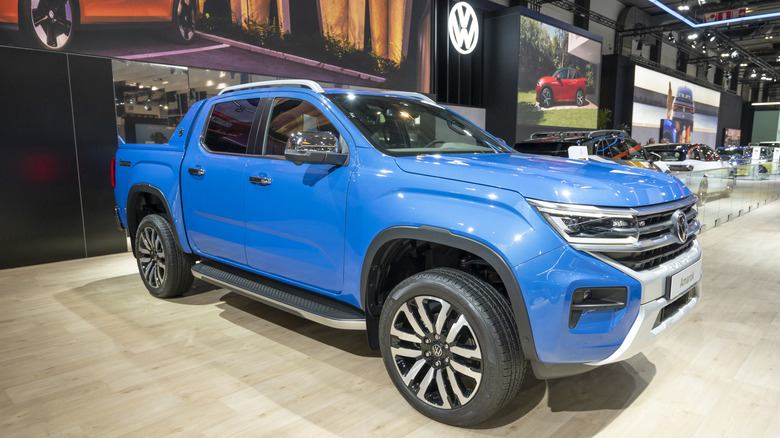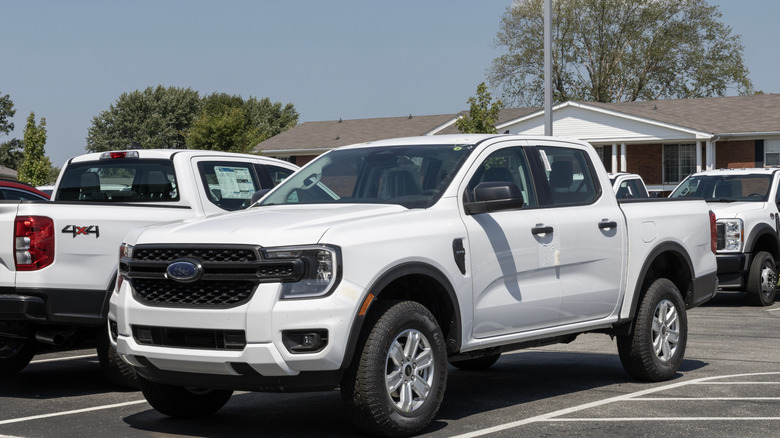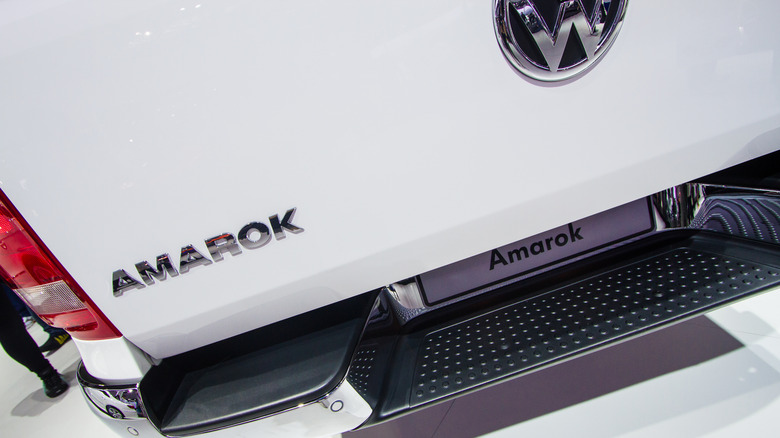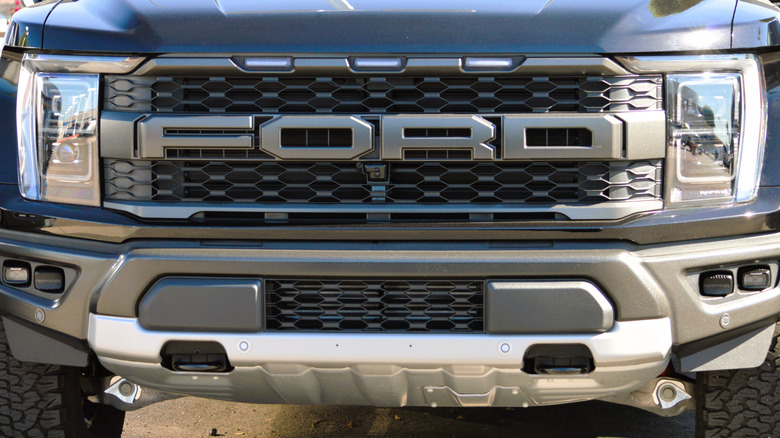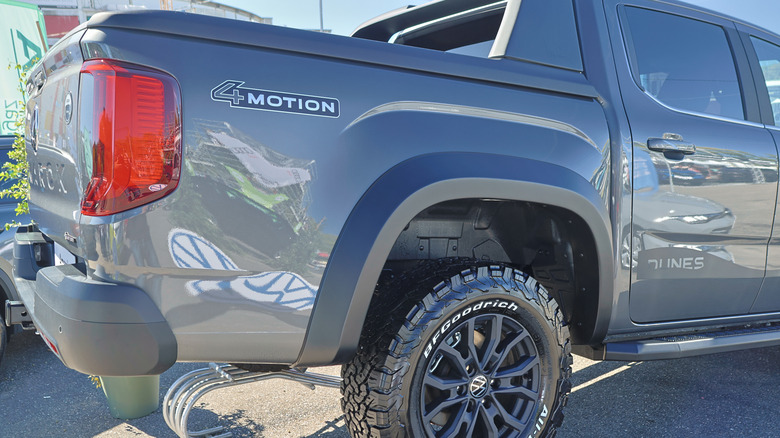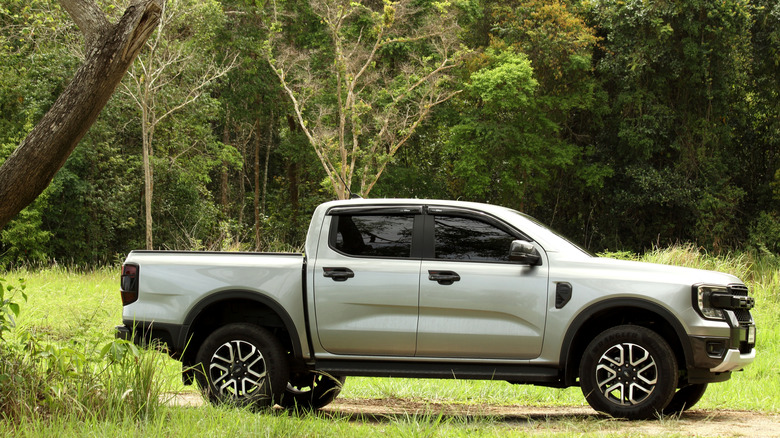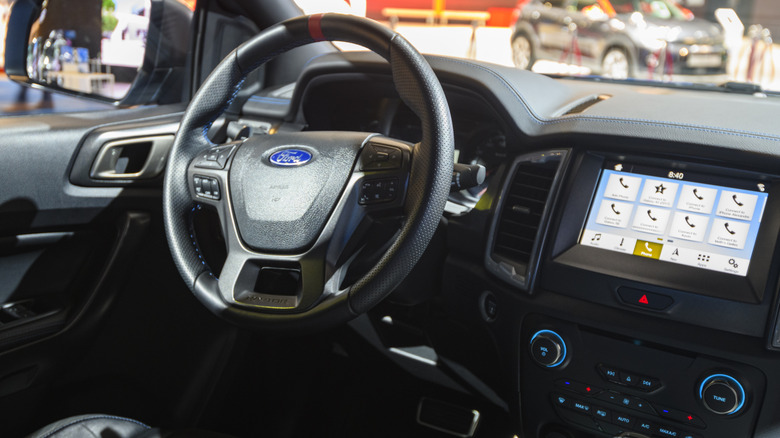VW Amarok Vs. Ford Ranger: Are They Really The Same Pickup Truck?
For the uninitiated, it can be very difficult to tell one vehicle model family from another. Some, for competition's sake, are very similar to those of rival manufacturers, both on the inside and the outside. This is particularly true with vehicle types that don't tend to look dramatically different from each other anyway. Pickup trucks, for instance, tend to be designed for rugged practicality, and don't generally strive to look innovative or unique.
With this in mind, and also considering that the same vehicle is sometimes known by a different name and under alternate branding around the world, things get confusing quickly. The question of whether a Ford Ranger and Volkswagen Amarok, VW's best pickup, are the same model is quite tricky. After all, many vehicles are built on the same frame, and adapted for sale in other markets, but aren't strictly the same machine.
Let's take a look at the histories of these Volkswagen and Ford models, where and how they intersect, and what sets them apart from each other. We'll also consider the specs of the two model families and their availability around the world.
The introduction of the Ford Ranger and the Volkswagen Amarok
Being a titan of the auto industry, Ford has a repertoire encompassing just about every type of vehicle a driver could hope for. In the pickup arena, one of its most notable offerings is the Ranger, which debuted in 1983. It had the option of a 2.3L overhead-camshaft engine with 116 pound-feet of torque and offering 80 horsepower, with its as-standard specs dropping to 104 lb-ft and 73 horsepower, equipped with a 2.0L overhead-cam engine. It wasn't the most formidable ride around at the time, but it was sufficiently robust to kick off decades of the wider Ranger family.
Volkswagen's Amarok is a sprightly youngster in comparison, first seen in 2010, almost three decades later. By this time, the Ranger was almost at the end of its third generation, and at the temporary end of its time on domestic sale in the United States. The fourth-generation model, spanning 2011 to 2019, wasn't initially sold in the States, not arriving there until 2019.
In terms of raw power, it's comparable to the Ranger, but the first and most important difference between them for U.S. pickup enthusiasts is that the Amarok has never been available in the United States.
The Amarok and Ranger are both (essentially) Ford-built models
It's vital to address why the Ranger and Amarok are often considered such close counterparts. There's no denying that they are similar in performance and are very closely connected in their origins.
Typically, the world's biggest automakers consider each other rivals, not allies. In the pickup sphere, a model bought from another manufacturer is a pickup sale Ford missed out on. At the same time, though, great things can happen for both parties in the corporate world when there's collaboration. The Amarok, then, is ultimately the joint work of Volkswagen and Ford. From the beginning of its second generation onward, that is.
The Ford plant in South Africa oversees the production of the second generation Amarok, one of the best-looking trucks VW ever designed. The Ranger and Amarok share a lot of similarities, inside and out, but this isn't to say that they're exactly the same. In 2020, South Africa's Car Mag quoted Thomas Sedran, chairman of the board of Volkswagen Commercial Vehicles, as saying, "What is important for both partners is the utilisation of the same platform," but adding: "Through custom designs and interfaces we will clearly differentiate the two models."
A Ford-built vehicle, then, isn't necessarily a Ford model. Volkswagen is keen to emphasize the differences between the two, so the next crucial piece of the puzzle is to take a closer look at their specs.
Differences in specs between the Ford Ranger and VW Amarok
For a lot of drivers, the most critical aspects of any vehicle are its raw specs. They're also one of the most prominent ways of telling otherwise-similar models apart. The Amarok launched in 2010 with a 2.0L engine offering 161 horsepower and a potent 295 lb-ft of torque. That year's Ranger XL featured a 2.3L engine, with a net horsepower of just 143 and only 154 lb-ft of torque.
Historically the Ranger had been a compact pickup, but the Ranger model family would change dramatically in the twilight of its U.S. life. Ford determined that the compact pickup market was becoming increasingly less desirable to consumers — compact pickups represented just 2% of the market by 2010, as Derrick Kuzac, Ford's global product development president, told AutoBlog at the time. So the Ranger returned to the States in 2019 as a midsize pickup like the Amarok, rather than the compact pickup it had previously been.
For the 2024 model year, the base trim of the Ranger features a 2.3L engine again, now upgraded to 270 horsepower and 310 lb-ft torque. This is contrasted with the '24 Amarok base model's 2.0L engine, offering 168 horsepower and 299 lb-ft of torque.
The design process for the Ford Ranger and VW Amarok
While the Amarok's later models were built in a Ford factory and wield Ford diesel engines, the American auto heavyweight hasn't monopolized its development, and the Amarok isn't simply a Ranger by a different name. Volkswagen has been careful to stamp its own identity on the model family.
The design process, Australia's Drive magazine explained, was marked by an interesting take on collaboration. Designers from Ford and Volkswagen, though working on the same project, did so separately. The objective of this was to ensure that both teams arrived at a final design independently, with the Amarok a project of Volkswagen's approach and the Ranger a product of Ford's. This meant that there was no compromising on a single design that, ultimately, wouldn't fully evoke the spirit of either.
With some sister vehicles, there's little to tell the brands' efforts apart, beyond the logo proudly placed on its body. The differences between the Ford and Volkswagen pickups are certainly subtle, but they serve to reiterate the fact that they are not one and the same. Their 2023 models are differentiated by some distinctive VW and Ford touches, from the Ranger's larger, more prominent headlights and front grille to the layouts of the trucks' interior instruments. Drivers familiar with either Volkswagens or Fords will surely recognize certain elements of their vehicles as being distinctly one or the other.
The dimensions of the two models
Aesthetically, then, there are some important at-a-glance differences an observer can use to easily tell the Amarok from the Ranger. Their respective size probably isn't one of them, though, as there's very little to choose between them in this area.
Comparing the '23 Volkswagen Amarok Style and the '23 Ford Ranger Sport, Drive concluded that Ranger was less than a third of an inch wider and just over three-quarters of an inch longer. With a shared height of just over 6 feet, there was no separating them at all. In terms of mass, there is at least something separating the two, with the Amarok at 7,385 pounds compared to the Ranger's 7,231.
Though there's little to differentiate them here, both are heftier pickups than the earlier generations of the Ranger. This example, however, is a comparison only of specific trims of the two model families. Both vehicles are available in a range of trims, and they further allow Ford and Volkswagen to make their own unique marks.
Trim differences
Though base models can be similar within vehicle families, they might distinguish themselves with their selection of trims. Let's take a look at both models' most recent lineups and how their prices compare.
Volkswagen's lineup for the '24 Amarok includes a quartet of options, coming in Life, Style, PanAmericana, and Aventura flavors. The base model is the Life, available in the U.K. beginning at 42,114 pounds with Britain's value-added tax factored in (the equivalent of $52,773). The price of the '24 Amarok there ranges up to 59,418 pounds ($74,442 including VAT) for the costliest trim, the Aventura.
For 2024, the Ford Ranger is available in XL, XLT, Lariat, and the formidable Raptor models. The XL is the standard model, and for the current model year, it begins at only $32,820. The most expensive Ranger, the Raptor, has a suggested price of $55,720, itself rather high for a midsize, as noted in SlashGear's otherwise-glowing review of the '24 Ranger Raptor.
Additional costs depend on exactly what else the new owner would like to include. But regardless of these choices, the Amarok is typically different in another crucial area: It's usually more expensive.
